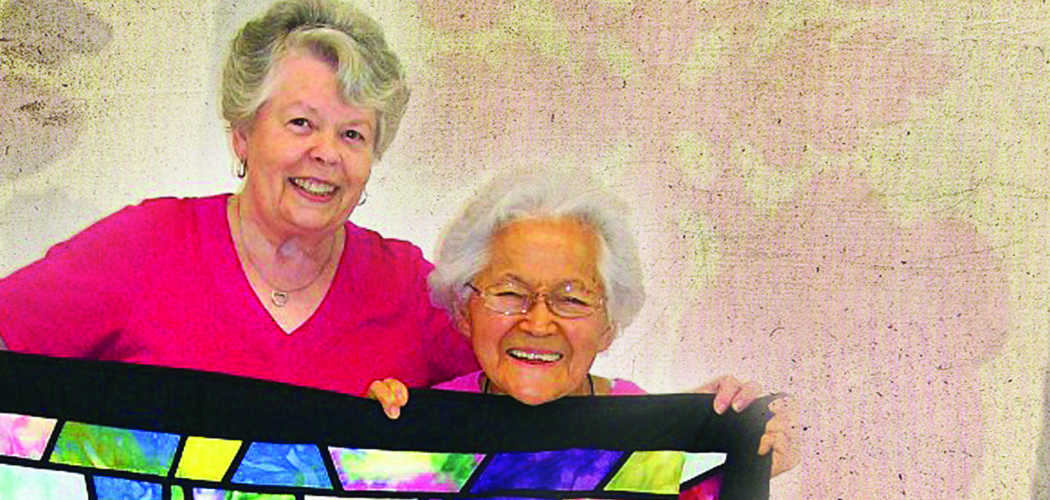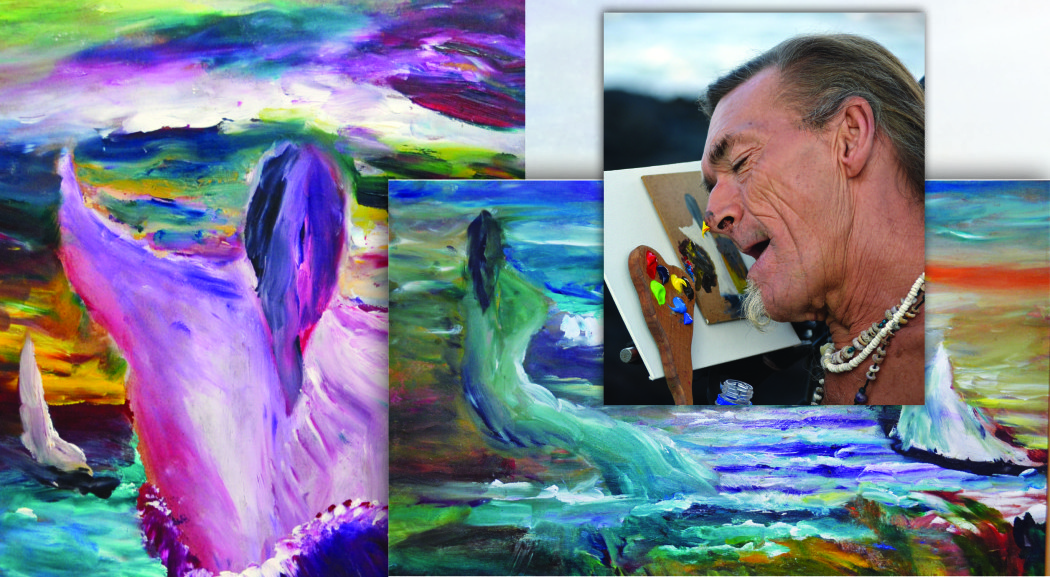
Hawaiian Quilting: Creating Treasures, Passed Down from Generation to Generation
 By Margaret Kearns
By Margaret Kearns
Scattered around Hawai‘i Island, small groups of women—and a handful of men—are using passion and knowledge, skill and patience, hands and hearts to save what they say is a dying art.
Hawaiian quilting is literally a labor of love with deep roots in the culture of these islands. Created completely by hand, often with many hands contributing to the effort, Hawaiian appliqué quilts are rarely found for sale, since most are gifted to family and friends, and then handed down from generation to generation, according to Kathy Tanaka, member and spokesperson for Ka Hui Apano O‘Waimea quilt
club in Kamuela.
“Most of Hawai‘i’s master quilters have been practicing their art from childhood, a skill learned at the hips of their mothers and grandmothers who patiently and lovingly shared their knowledge of the craft and wisdom on how to—and how not to—work on a quilt,” Tanaka says.
One of Ka Hui Apano O‘Waimea’s founding members, 92-year-old Stella Akana, is among the kūpuna in the group who advise those new to quilting: “Always quilt with good thoughts. If you are angry or agitated about something, put it down,” a sentiment that is based in Hawai‘i cultural traditions and the belief that what you do should be done from the heart with aloha. Only then is it pono (in perfect balance and harmony, proper, righteous, good).
“Stella’s work is absolutely perfect from the patterns to the stitching,” Tanaka says. “She continues to be extremely active and creates large quilts (queen and king sized) in half the time it takes most of us,” she adds.
And time is exactly where patience comes in! To create the larger, queen and king sized quilts requires a minimum commitment of two years and often up to five years, depending on how much time you spend on the project each day, according to one of the group’s long-time members and past presidents, Irene Kubo.
Ka Hui Apano O‘Waimea, the oldest quilt club in the state of Hawai‘i (founded in 1972), is one of five formal clubs dedicated solely to Hawaiian quilting on Hawai‘i Island with locations stretching from Volcano Village to Waimea. Currently, Ka Hui Apano O‘Waimea is comprised of 45 members with 20 or so actively attending monthly meetings held the last Saturday of the month at St. James Episcopal Church in Waimea. Members bring quilts in progress, share ideas and talk story from 9 a.m. to noon.
Kubo, who served as president for nearly two decades (“Most of the ‘80s and ‘90s,” she recalls), joined Ka Hui Apano O‘Waimea in 1976 and says that one of the group’s objectives—and indeed, its biggest challenge—is perpetuating the art of Hawaiian quilting by encouraging more young people to get involved.
“Most of us are retired with time to devote to quilting; we need more young people to keep it going. About five to 10 years ago we enjoyed a swell of strong interest in the art of Hawaiian quilting, but now it’s waned again; it seems to come in waves,” Kubo says. “It’s not only the beauty of the art, but the camaraderie we all enjoy that we want to share and perpetuate—not to mention quilting is the best and cheapest therapy there is,” she quips.
An encouraging sign: the club’s current president Cyndy Martinez oversees monthly meetings with both daughter and granddaughter at her side. In addition to family recruits, the club generates new interest by its Hawaiian Quilt Show held every other February (on the last Saturday of the month) at Kahilu Hall in Waimea. The next club show takes place in 2013, according to member Mary Hinck, as this February, 2012, the group is joining forces with all North Hawai‘i quilting clubs to present The Festival of Quilts, featuring quilts of various styles and techniques. The one-day show, she says, will take place in conjunction with the annual Cherry Blossom Festival in Waimea on Saturday, February 4, from 10 a.m. to 2 p.m. While most of the quilts will be on display only, a small number will most likely be offered for sale, as well, Hinck says. Clubs presenting their work are the Sew N Sews of Waikoloa, Anuenue Quilters of North Hawai‘i, Mauna Kea Quilters, Laulima O Hamakua, Sew Fun After School Program and Ka Hui Kapa Apana O‘Waimea.
History of Hawaiian Quilting
Traditional ancient Hawaiian bedcoverings were made of kapa, a cloth made from the inner bark of native trees. Strips of this bark were beaten and felted together to make a smooth cloth that was soft to the skin. Kapa moe was kapa made into a bedcovering. Kapa moe was made in layers similar to today’s Hawaiian quilt, which emerged in the 1800s. The layers of Kapa moe were connected only at one end so individuals could adjust the number of layers required, depending on the temperature outside. Often the kapa was scented with fragrances made from native flowers, and the top sheet of kapa was dyed and stamped with an overall graphic design. Some quilts suggest the traditional Hawaiian appliqué designs found in kapa moe, but the kapa designs were geometric as compared to the flowing designs of Hawaiian appliqué quilts emerging over the past two centuries.
It was following the arrival of the first New England missionaries to the islands that native Hawaiians began to use fabric. The missionary women taught them the fine art of needlework through their patchwork quilts which were made from scraps of fabric—an early American tradition.
It did not make sense to the Hawaiians, who had no scraps, to cut up bolts of fabric into little pieces and sew them back together. A popular story says a breadfruit pattern was the first truly Hawaiian quilt design, and it remains the “trademark” design of a Hawaiian quilt. Some Hawaiian women laid some fabric on the grass to dry, the story says, when they noticed the leafy shadow cast upon it from the branches of the breadfruit tree overhead. A Hawaiian woman went to the fabric and cut out the pattern, then laid it onto another fabric and stitched it, thus the birth of the first Hawaiian quilt—an appliqué quilt, as opposed to patchwork. From there, many designs based on plants and flowers were created by the talented Hawaiians, who caught on quickly to the process.
Now, in Hawaiian tradition, you should start with a breadfruit design and you will have a fruitful life, never hungering for wisdom or knowledge. This tradition of starting with the breadfruit is a very spiritual journey and will ensure that Hawaiian quilting becomes a part of your life.
Today’s quilters like to flock together in groups. The first club, Ka Hui Kapa Apana O‘Waimea, was formed on July 29, 1972. With a State Foundation on Culture and the Arts Hawaiian Cultural Studies grant, the Hawaiian Civic Club of Waimea initiated a two-year workshop studies program on Hawaiian Quilting. The evident widespread interest in Hawaiian quilting encouraged those involved to continue by creating an organization devoted exclusively to Hawaiian quilting. Ka Hui Kapa Apana O‘Waimea was founded as a non-profit organization with two essential objectives: to gather members of mutual interest in friendly fellowship and to preserve, perpetuate and encourage the art and culture of Hawai‘i in the field of Hawaiian quilting. To accomplish these objectives, the organization developed a system for its members to share their Hawaiian quilt expertise and knowledge. Through generous cooperation, members contribute Hawaiian quilt patterns to a collection file that the organization maintains and makes accessible for use by all members. Over the years, this process established a large pattern library that forms the foundational structure for continual instruction.
The group participates in numerous community festivals each year, Badua says, offering free classes and small samples to festival-goers. In addition to these annual festivals, they take the art of Hawaiian quilting into classrooms at local schools and to various clubs and organizations on the island.
“Whenever and wherever we have an opportunity to teach, we do it,” says Badua, who took over the leadership reins from Kubo in 2000, holding them through 2010, when Martinez stepped in. Teaching is one of the best ways to spread awareness and appreciation for this Hawaiian art form, she says.
Contact writer Margaret Kearns at margaretekearns@gmail.com.
Find a club near you on Hawai‘i Island and find locations to view year-round displays of this treasured Hawaiian art form in the listings that follow:
Hulihe’e Palace in Kailua-Kona. 75-5718 Ali‘i Drive. Open Tuesday-Saturday, 10:30 a.m. to 3 p.m. Closed major holidays. The summer palace for Hawaiian Royals, original furnishings and artwork are on display. For more information visit: Hulihe ‘e Palace.
Lyman Museum & Mission House in Hilo. 276 Haili Street. Open Monday-Saturday, 10 a.m. to 4:30 p.m. Closed major holidays. Featuring numerous examples of traditional Hawaiian art and furnishings, including Hawaiian quilts. For more information visit: Lyman Musuem.
Aloha Quilters of Kona. This club meets at Wallace Hall in the Christ Episcopal Church, Konawaena, on the third Saturday of each month (except November and December). For more information, contact: saraalv07@msn.com.
Ka Hui Apano O ‘Waimea. Members meet at 9 a.m. on the last Saturday of the month (except November and December when they meet on Wednesday) in St. James Circle at St. James Episcopal Church, Waimea. For more information, phone: 775.0765 or email:
rktanaka@hawaii.rr.com.
Mauna Kea Quilters’ Guild. Established in 1977, the group meets the second Saturday of each month (except November and December) from 9:30 a.m. to noon in the Thelma Parker Memorial Library meeting room, Waimea. For more information, phone: 937.2159.
Tutu’s House. A non-profit community center in the Kamuela Business Center, 64-1032 Mamalahoa Highway, Waimea. Offering numerous classes and presentations, the Tutu’s Quilters class meets each Monday at 9:30 a.m. For more information, phone: 885.6777 or email:
tutus@tutushouse.org.
Volcano Quilt Guild. Located in Volcano Village, this small group meets at 6 p.m. on the first and third Wednesday of each month. For more information, phone 967.8080.
Hawaii Island Quilt Supplies (Some retailers listed below offer classes, as well. Contact them directly for details):
Dragon Mama, 622 Kamehameha Avenue, Hilo, 934.9081.
Specializing in Japanese fabrics and kimonos.
Fabric Gift Shoppe in Kona Old Industrial Area, 74-5599 Luhia St
Unit D-5. 329.8177. Great selection of fabric, notions and patterns
Kilauea Kreations, Volcano Village, 967.8090, and Kilauea Kreations II, 680 Manono Street, Hilo, 967-8090. Featuring
Hawaiian prints, batiks, and Moda hand-dyed fabrics.
Kimura’s Fabrics on Highway 11 in Kainaliu Village, 322.3771. Kimura’s stocks a huge selection of fabrics as well as notions, craft supplies and Hawaiian quilt kits.
Quilt Passions, Kailua-Kona, in King Kamehameha Mall. Offers classes for adults and keiki (call for times). Open Mon-Fri 10 – 5; Sat. 10 – 4 329.7475 www.quiltpassions.net
Top Stitch, 64-1067 Mamalahoa Highway, Kamuela, 885.4482. A small shop with many supplies for both Hawaiian and American quilting styles. They sell fabrics, notions and gadgetry for the quilter and carry an extensive inventory of Hawaiian appliqué pattern books, Hawaiian quilt block patterns and Hawaiian quilt pillow kits.


